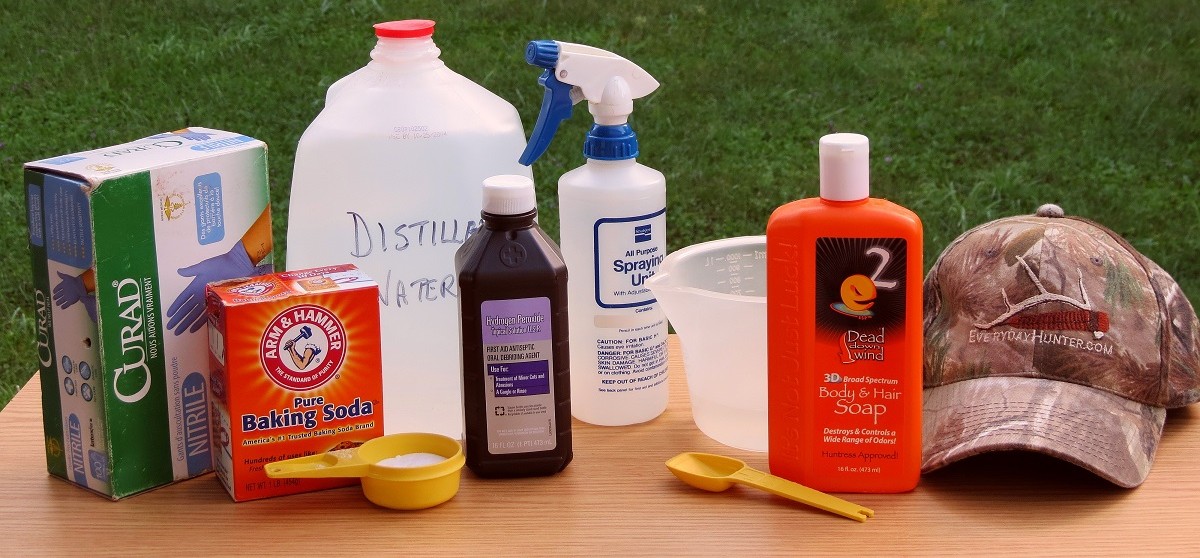You can spend a lot of money to keep your scent out of the whitetail’s nose. The scent control companies help with anti-bacterial soap, scent-free deodorant, odor-neutralizing laundry detergent—even special toothpaste and breath mints. And then there’s that bottle of brand-name scent-eliminating spray you’ve seen guys on TV shows squirting onto their clothing. Too bad you don’t have access to a never-ending supply!
Wait a minute—you do. It’s not free, but it works well and it’s almost free. You may or may not have heard that you can mix baking soda, peroxide and water to make an effective spray that will neutralize human odor. Lots of D-I-Y hunters swear by it. Some don’t. What’s the difference? How can some guys be right and others be dead wrong, when it looks like they’re doing the same thing?
 In addition to employing a quality scent control system, it’s still necessary to hunt according to the wind.
In addition to employing a quality scent control system, it’s still necessary to hunt according to the wind.
To answer these questions I began looking for the facts about homemade scent neutralizing spray. And I found the guy who actually came up with the formula. His name is Paul Krebaum, and he’s a chemist. His problem was not how to make himself invisible to a deer’s nose, but rather for his dog who kept getting tangled up with skunks. He tried everything he could think of to neutralize skunk odor, including bathing Rover in tomato juice. (That didn’t work.) Finally, in the early 1990s, he succeeded in making this simple, home-brew odor neutralizer. If you understand the facts about it, you’ll see why it works.
The formula
Begin with 8 ounces of distilled water. Dissolve one-eighth cup of baking soda in it. Mix in 8 ounces of peroxide (3% formula), and add a teaspoon of unscented soap. Stir, don’t shake, to minimize suds. This will yield a pint of spray. Pour it into a spray bottle and spray your layers of clothing inside and out. Use the whole bottle. (Keep reading and you’ll find out why.)
 All you need for mixing your own homebrew scent control spray is some peroxide (3%), distilled water, baking soda, and a tiny bit of unscented soap. Mix in the measuring cup and pour into your spray bottle. Make a fresh batch each time you use it.
All you need for mixing your own homebrew scent control spray is some peroxide (3%), distilled water, baking soda, and a tiny bit of unscented soap. Mix in the measuring cup and pour into your spray bottle. Make a fresh batch each time you use it.
Why the peroxide?
The molecular formula for peroxide is H2O2—two atoms of hydrogen and two atoms of oxygen. Notice anything about that? You probably do. It’s very close to water, which is H2O. The difference is that peroxide has an extra atom of oxygen in each molecule. That means it’s not as stable as water. That extra oxygen atom is like a stray cat—it wanders off. When it does, the H2O2 becomes H2O. That’s why you should use fresh peroxide because the longer it sits on your shelf the more ineffective it becomes.
The escape of that extra atom of oxygen is important because it destroys organic substances by oxidizing them. So, when your clothing is permeated by human scent (an organic compound), your scent is oxidized by the peroxide in your homebrew solution. However, the peroxide is no longer effective when it’s gone, and it soon disappears by evaporation (it dries) and by oxidization (the chemical reaction).
Why the baking soda?
Lots of people use baking soda in the refrigerator to absorb food odors. Baking soda in your scent neutralizing spray also absorbs odors, so once the peroxide is gone by oxidization and evaporation, the baking soda is left behind to absorb remaining odors. (Be sure you’re using baking soda, not baking powder which is something different altogether.)
Why the soap?
The soap acts as a surfactant—a fancy word that means the solution won’t bead up when you spray it. That means you’ll get an even coating of spray on your clothing. Only a tiny bit of soap is necessary—unscented so you don’t add a scent to something you’re using to destroy scent.
Why the distilled water?
The distilled water does three things. It dilutes the peroxide so it doesn’t bleach your clothing. It dissolves the baking soda. And it acts as a carrier for the rest of the ingredients. Use distilled water because it has no water softening agents, chlorine, or other water treatment chemicals in it. If those are present, the peroxide will immediately go to work oxidizing those compounds before reaching the scent on your clothing.
Those are the facts, but not everyone makes it the same way or with the same care. That’s why not everyone gets the same results. To keep you from being one of those guys for whom it doesn’t work, here are some things NOT to do:
What Not to Do
Don’t use more water:
Some people use anywhere from 2 to 8 parts water relative to the peroxide, but more water dilutes the peroxide, which is only 3% to start with. Equal amounts of water and peroxide cut the peroxide to 1.5%. Three parts water dilutes it to 1%, eight parts dilutes it to only 0.375%. Do the math. A solution with 1.5% peroxide is four times more effective than a solution with 0.375%. So don’t dilute the oxidizing agent any more than necessary.
Don’t use more baking soda:
When you spray the solution on your clothing it oxidizes scent trapped in the clothing. Once it dries, all that remains is a residue of baking soda which will absorb odor for a while, and a tiny bit of soap. More baking soda will take longer to dissolve and be more likely to clog up your sprayer. If you want to add baking soda after the liquids dry, you can always dust your clothing with it.
Don’t make it in advance:
If you like efficiency, you’re probably thinking – “I’ll make it by the gallon, and put it away for tomorrow’s hunt, and the next day’s and the next day’s!” Don’t do that. Krebaum says that within an hour or two the peroxide has oxidized, whether you spray it or not. Remember that stray oxygen molecule? It’s trying to escape and soon after you mix it you have nothing but water. The peroxide has disappeared. It can also build up pressure and possibly explode your container. Your homebrew has no shelf life so make only what you will use immediately, and make it each time you get ready to head to the woods.
Don’t rely on it like it’s magic:
A scent elimination spray does not constitute an entire scent control program. You still need to wash your clothing properly, store it away from odors, shower with unscented anti-bacterial soap, and do all the other things that prevent you from escorting foreign odors and human scent into the deer woods.
Myths and truths
Now that you know the truth about how and why home-brew scent neutralizing spray works, you can separate truth from fiction.
- Myth: It’s more effective if you use more peroxide. Not exactly. Too much peroxide will bleach your clothing and break down the fibers making your hunting garb wear out more quickly.
- Myth: It can’t work as well as the stuff the brand name companies sell. Yes, they have the advantage of research staffs and lots of field testing, but they’ll never tell you their formula so you can evaluate it for yourself.
- Myth: It works as well as the store-bought stuff. If you make it and use it properly it’s effective, but the brand name scent sprays have at least one thing your home brew doesn’t have—shelf life.
- Myth: You can add a cover scent to your homemade spray. You can’t, because the active ingredient is peroxide, which reacts to any organic compound. Adding a cover scent will make it less effective.
Here’s the bottom line: You can easily spend $100 or more per season on the brand-name stuff. If you do you’ll probably be conservative in how much you use. Why not set up a little lab in your kitchen, garage or on your back deck? Then conjure up your own homebrew, spray as much as you want, and go kill a whitetail.







